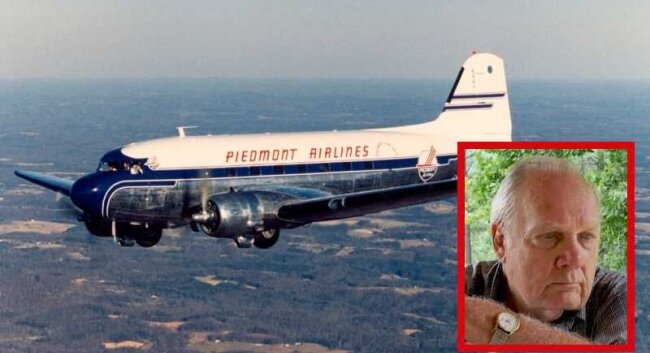Survivor's end: Bradley dies 54 years past Piedmont plane crash
The sole survivor of one of the most perplexing air crashes in American history and a celebrated visitor to the Crozet area, where he would memorialize the last flight of Piedmont #349, Ernest Philip "Phil" Bradley, has died after a short illness.
According to his son, the 87-year-old native of Clifton Forge lost a six-week battle with pancreatic cancer and died August 23 at a hospice near his home in Monroe, North Carolina.
It was a foggy night in Central Virginia nearly 54 years ago that sealed this name in the annals of aviation. A union organizer who'd spent the week in Oklahoma for the International Association of Machinists, Bradley missed his original Friday flight due to a late connection– but snagged the last seat on a regularly scheduled flight from Washington to Roanoke. By 9pm, the plane, a twin-engined DC-3, was overdue for its stop in Charlottesville.
The October 30, 1959 incident launched what was widely described as the era's greatest search-and-rescue operation, as teams of helicopters and fixed-wing aircraft spent the next 36 hours searching a multi-county swath of Virginia landscape. As pundits pondered how a commercial airliner could disappear over American soil, concerned family members and media swarmed the local airport.
Meanwhile, Bradley was enduring the struggle of a lifetime on the peak that looms over the town of Crozet in Western Albemarle, Buck's Elbow Mountain. Belted into his chair, the rearmost seat in the plane, Bradley had somehow catapulted out of a hole torn into the aluminum fuselage and come to rest on the rocky forest floor near Shenandoah National Park.
Daylight would bring evidence that Bradley had narrowly missed jagged boulders and mammoth stone outcroppings. Daylight would also show scenes of hideous human carnage. What daylight didn't bring, however, was a rescue. Continued spates of rain and fog conspired with a dense canopy of trees to block spotters from seeing the wreckage.
Compounding the injured man's woes were a cruel combination of rain, unusually high winds, and near-freezing temperatures. But on Sunday morning, November 1, what would have been Bradley's third day on the mountain, a glint of morning sun would bounce off the crumpled aluminum, and rescuers soon arrived on foot.
No stranger to carnage, Bradley had earlier received the Bronze Star for his service in the U.S. Navy during the D-Day invasion in Normandy. He would later credit his mountain-side survival to a something he says he encountered as the craft began striking trees, an illuminated vision of Jesus Christ clad in white robes and speaking these words: "Be concerned not; I will be with you always."
After two months recuperating at the University of Virginia Hospital, Bradley would return to making business trips, and he got so comfortable with flying that, in 1980, he earned his own license to pilot private planes.
In 1999, using his own savings and the construction help of his son, the sole survivor unveiled a granite marker and pavilion at Mint Springs Park, near the crash site. The monuments list the names of the 23 passengers and three crew members who perished.
While the government and the Airline Pilots Association sparred over the cause of the crash, Bradley became a popular speaker to civic and church groups, typically choosing a theme of perseverance, according to his son, E. Philip "Brad" Bradley Jr., who says that his father took the words of that Christ vision to heart.
"There are ups and downs in life, and he never worried about anything," says his son, "As recently as last Saturday, he was walking and talking and cutting up and joking."
In April of this year, Bradley sat down with producers of a British documentary film team to answer questions in a 60-minute film entitled, "I Survived a Fatal Flight." The film debuted in late July on Britain's Channel 5. One question that the survivor struggled with, however, was why was he spared in the crash?
"Maybe it was to have me and the three grandchildren and touch so many people's lives," says his son. "You wouldn't believe the amount of people who have called."
Don Stokes was one of them. A retired aviation manager living in the town of Forest, Stokes choreographed what would have been Bradley's swan song, a multi-city tour aboard a restored DC-3. However, on the eve of the 2010 event, mechanical worries grounded the vintage plane.
He was like, "Oh, well. I'll just come up in a truck, son," Stokes recalls.
The large man with the ready laugh was also appreciated by Winston-Salem resident Michael Haley, who– as a 13-month-old– lost his father, co-pilot Bascom Lee Haley, in the crash.
"He gave you all of his time," Haley says. "He always took my saddest moments and turned them into happiness. He was like the crash therapist."
Haley says that his sadness at the death of this sole survivor is tempered by memories of Bradley's humor and the religious faith sparked by Bradley's story of the spectral Christ.
"I really hope," says Haley, "that Phil can now see the rest of that bright light that he saw on the mountain that night."

4 comments
He was a pleasure to know and speak with a number of times regarding the crash- glad you and I were able to "confirm" his suspicions as to what actually happened that evening.
He was a pleasure to know and speak with a number of times- glad you and I were able to "confirm" his suspicions as to what actually happened that evening.
That gentleman had quite a life. It was great of him to put up the memorial.
I was a youngster when this tragic crash happened and took the life of my neighbor. Phil Bradley's survival really was quite powerful for our neighborhood and gave us hope. I still remember. It sounds like he went on to have quite a remarkable life.